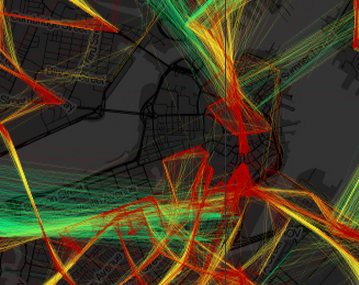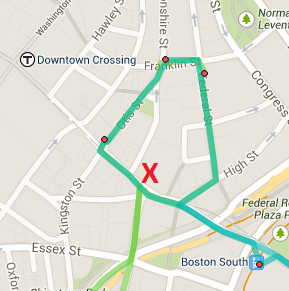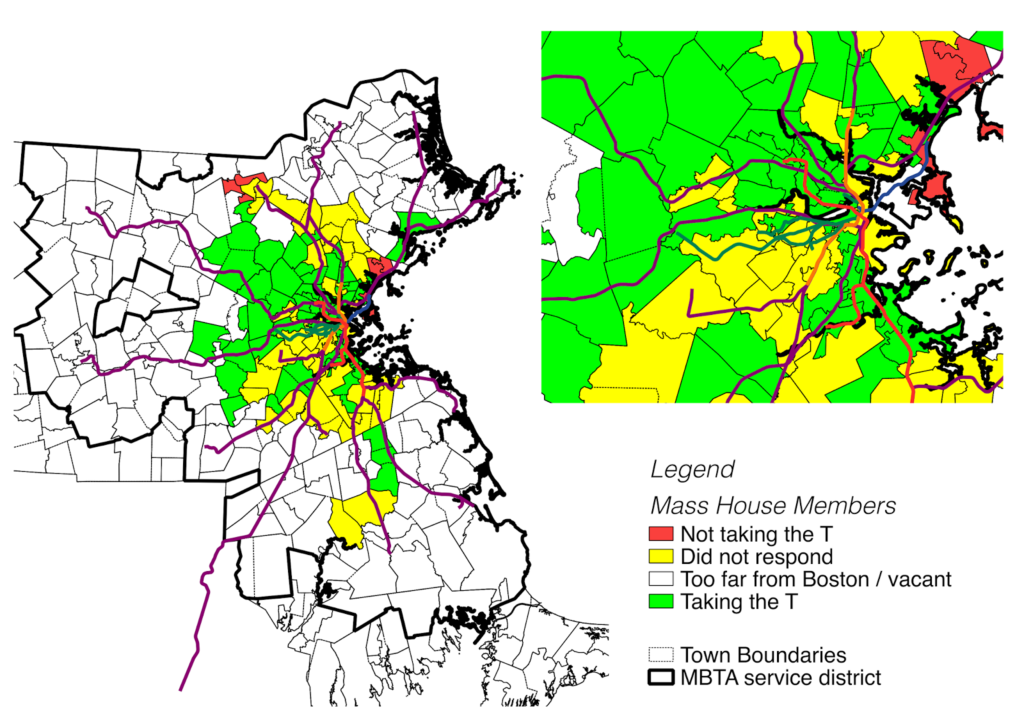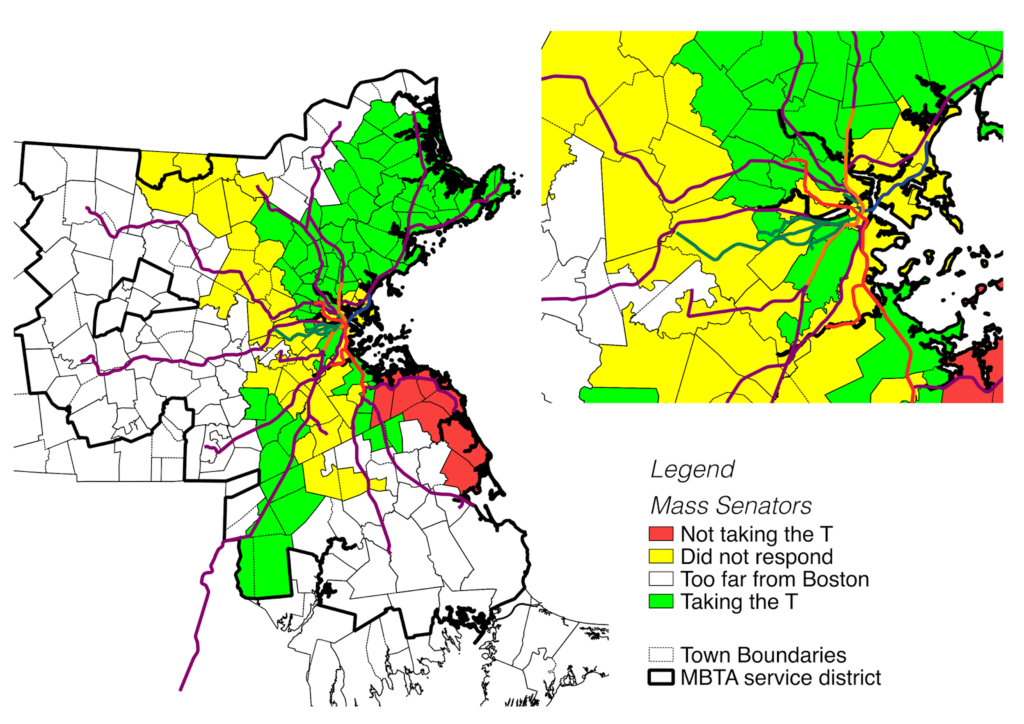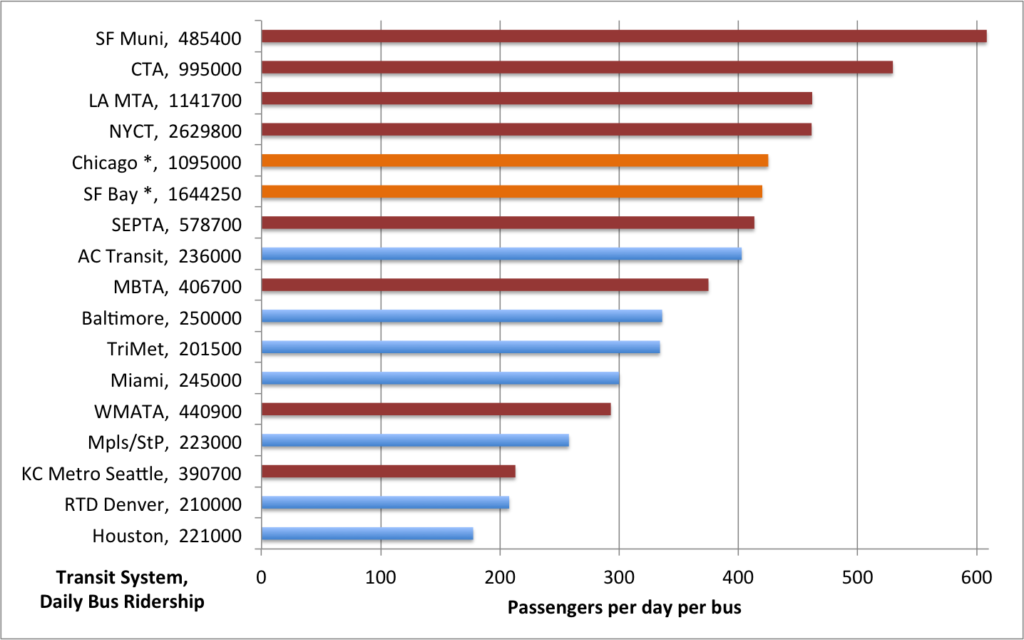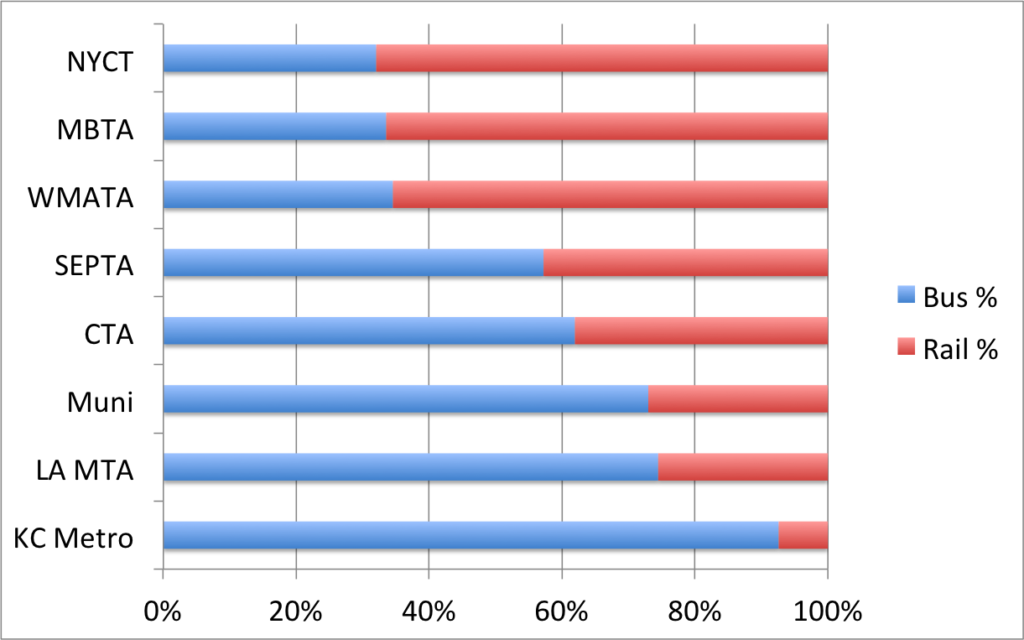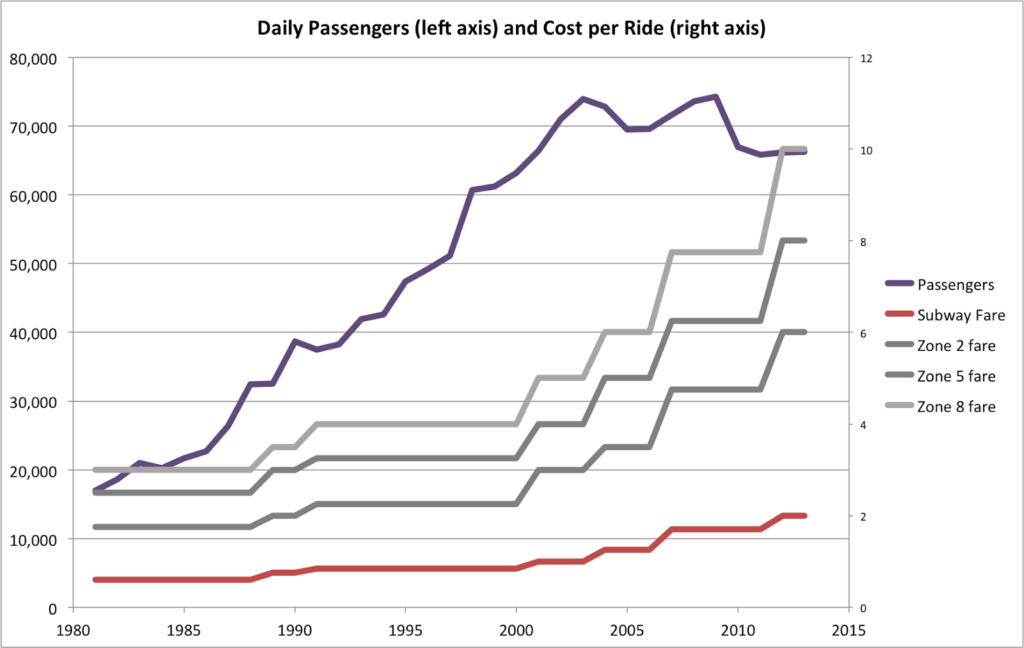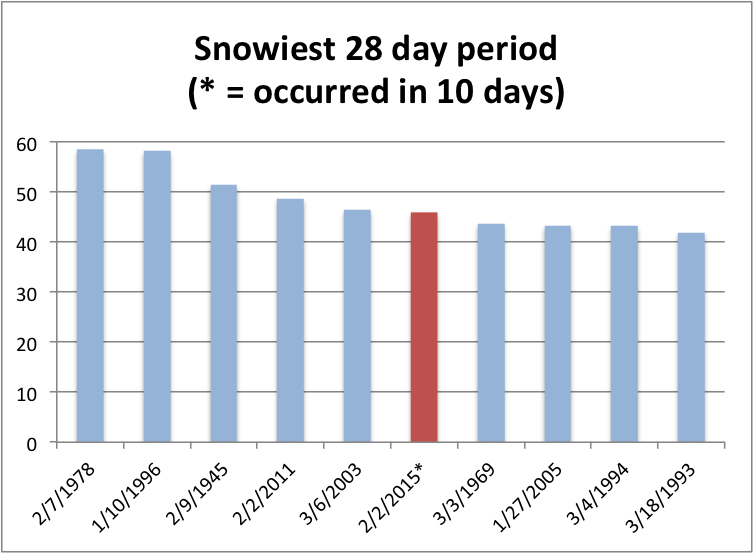This is sort of a post-live blog from Transportation Camp NE. One of the first sessions was regarding all door boarding on the MBTA. There are a lot of ins and outs—notably, that you have to account for all scenarios where people could access the system, for example potentially without paying a fare (Silver Line airport) or having proof thereof (boarded with a friend who paid and parted ways)—but it was a good discussion, and something that is moving forwards, but needs to move faster. I pointed out that the discussion needs to not be pushed by the small minority who complains (loudly) about fare evasion, or really by fare evasion at all, but by vehicle speed and efficiency, since 95% or more of passengers already pay their fare: we need to improve service for the vast majority.
Author Archives: Ari
Downtown Boston is Busmageddon? Really?!
Update: A shortened far less ad hominem version of this has been published in Commonwealth Magazine.
Every so often an article comes along which is so inane, so poorly researched and so utterly stupid that it requires a line-by-line refuting.
The article in question, which has a dateline of March 31 so I’m assuming it’s not an April Fools joke, is:
End downtown Boston’s busmageddon Add reworking bus routes to the MBTA’s to-do list
Oh boy.
The first four paragraphs go on about how people are taking public transit in Boston. Fine. Then you get to paragraph 5:
We need a comprehensive policy regarding usage of the public way.
Good! We agree. We do need a comprehensive policy regarding usage of the public way. Right now, approximately 75% of the roadways in Downtown Boston are dedicated to automobiles. Another 20% are sidewalks, and 5% are bike lanes. Yet the number of cars is decreasing (to quote the author two paragraphs earlier), and the majority of people coming to Boston don’t use cars. So why do cars (as usual) get the vast majority of space? Why should they get all the real estate if they only account for a minority of travelers? Who knows.
Loading must be done during limited hours, as is the case in other great cities.
Loading? Fine. That’s a halfway-decent point. Care to elaborate? (Apparently not.)
To keep the city from devolving into perpetual gridlock, we also must address tour buses and MBTA buses downtown.
Boston has no through bus routes through downtown, the only city in the country to do so. Perpetual gridlock? How much of the gridlock downtown is caused by buses at Haymarket (in their own terminal, mind you), the Franklin-Federal loop, the Silver Line and a few other sundry routes, as opposed to, say, tens of thousands of cars trying to ply narrow streets downtown? Tour buses? Sure, get rid of those space-hogging menaces. But getting rid of a few MBTA buses? Please.
And what of these other great cities? What do they have in common? London? Bus lanes. New York City? Bus lanes. Minneapolis? Double bus lanes. Boston? Well, we have the Silver Line, but it barely has bus lanes downtown.
Let’s get the buses off of our streets so that pedestrians and bicyclists can be safe.
Red herring! Red herring! Red mfing herring! T Buses account for, oh, maybe 2% of traffic downtown. Maybe. Probably less. Certainly far less than any other city in America. Take a look at Bostonography’s great bus speed map (a screen capture to the right). Notice that there is actually a gap in Downtown Boston with no bus service. Compared to nearly any other city in the country, Boston has less bus service in its downtown. Other top bicycling cities like Minneapolis, Seattle, San Francisco and Portland have many more buses, yet no one is demanding that buses be pushed to the outskirts there.
Yet buses are menace to pedestrians and bicyclists? Should we consider doing something about the other 95% the traffic downtown? The cars? Or are pedestrians and cyclists somehow immune to them?
As Doug Most reminded us in The Race Underground, Boston constructed the first subway tunnel in the late 1890s to get trolleys off the street; we can certainly do likewise today by making good on the commitment to a tunnel connecting South Station with the Silver Line spur that heads to Dudley Square.
Oh, good lord. Yes, we could spend $2 billion to build the Silver Line Phase III tunnel. Somehow this would solve all of our transportation problems. Except for the buses going to Haymarket, South Station and all of the express buses. It wouldn’t really get any cars off the street (although by his logic, cars on the street aren’t the problem). It would create a low-capacity, slow route that could be replicated for 1/100th of the cost with signal priority and bus lanes. But that might impact cars and their drivers dense enough to think the best way to Downtown Boston is to drive.
There is also no reason why people wanting to go to Salem should have an express bus waiting for them around the corner from Macy’s …
Most people going to Salem don’t wait by Macy’s: they wait at the Haymarket bus station. (Also, if you’re actually from Boston, it’s Jordan Marsh. But I digress.) It’s not perfect, but it’s covered, and the buses pull in to a busway to load and discharge passengers. But so what if they do? Downtown Crossing is right in the center of the city. If we make people from Salem walk ten minutes, or squeeze on to an already-over capacity subway train, they’re more likely to say “the hell with it” and drive. Do cars cause congestion? Or just the 16 buses per day that run from Salem to Downtown Crossing?
… nor should city street patterns necessitate that a bus make a left turn from a right lane to meander through downtown streets to get to the Mass Pike.
The 500-series buses do load on narrow streets and have to reach the Mass Pike. Why? Because they are basically the replacement for the other two tracks of the Boston and Albany railroad. When the tracks were paved over for the Turnpike, the 500-series buses replaced local service there. There were proposals in the ’40s to run service similar to the Highland Branch from Park Street, out the Tremont Street portal, on to the tracks parallel to the current Worcester Line, and out to Allston, Brighton and Newton (huge file here). Instead, we had got the Turnpike, which express bus service, which is express until it sits in Turnpike traffic. If you hadn’t built the city for cars, you wouldn’t have to worry about the buses; the streetcars could be underground in that aforementioned tunnel.
Large buses making wide turns on narrow downtown streets, even more narrow because of mounds of snow, clog the streets and imperil the safety of the public.
Large buses clog the streets? What about parked cars? What about moving cars in traffic? How about we eliminate downtown on-street parking and give the buses their own lanes, and make sure the mounds of snow are removed from them. And do only the buses imperil public safety? No pedestrian has ever been killed by a car, right?
We should eliminate bus lines which make no sense and relocate the terminus of lines now heading downtown to South Station and North Station …
We have an intercity bus terminal at South Station. It’s at capacity. There’s no way to add T buses in to it. And it’s a five minute walking transfer to the already-over capacity Red Line. The current routes that could conceivably go to South Station aren’t perfect, but they seem to work. Maybe we should create a network of downtown bus lanes instead? Cyclists and pedestrians would know where the buses would be, and it would help buses move through downtown more quickly.
And North Station? That’s why we have the Haymarket bus station. It has room for buses and easy connections to the Orange and Green lines. Perhaps when the Government Center Garage is rebuilt, it will include a better bus terminal and connections, and bus lanes across the bridge to rebuilt bridge to Charlestown.
… where there is access to underground transit, commuter rail and the interstate highway system.
Yes, there is access to underground transit. That’s all well and good. Except that underground transit is growing faster than other parts of the system, while struggling with decades-old equipment and overcrowding. Most downtown buses operate like commuter rail: they go from the suburbs to the city. There’s little need for passengers to transfer to commuter rail, rather they want to transfer to their place of work. Instead of dropping people at the outskirts of downtown, we should have more central bus routes that balance operational efficiency with getting people where they want to go. Give as many people a one-seat ride and a comfortable place to wait, and they’ll be more likely to ride.
Even as we eagerly await the Red Sox return to Fenway Park, and the melting of the last mounds of snow (most likely in that order), we should be thinking – and planning – ahead.
If you really want to encourage safer streets, getting rid of transit is certainly not the way to go. Planning ahead will certainly be important, but let’s plan the right way. The right way might be a congestion charge, to get cars off the streets at peak times. The right way might be to build bus lanes so that bus riders have seamless trips through downtown to their destinations. The right way might be to require tour buses, an actual menace to pedestrians and cyclists which provide no actual public good, to stick to certain streets, routes and times.
Or the right way may be to raise the goddamn parking tax. Right now, Boston has one of the lower parking taxes around. Because parking is very much constrained, it is not subject to the whims of supply and demand: a daily tax on parking spaces would likely not even affect the consumer price much, but move some of the profit from the property owners to the city. Given the negative externalities of cars on city streets, and the fact that most people utilizing parking spaces are from out of town, the city should raise taxes and use the money to improve public transportation, perhaps starting with, that’s right, buses.
So the right way is not to demonize public transit and couch it in the guise of pedestrian and bicycle safety is disingenuous at best. Ignoring the fact that nearly all traffic downtown is made up of cars driving on subsidized roadways and offering debunked solutions is a farce. Note the red X on the map to the right. It shows the location of the author’s office in relation to the 448/449/459 and 500-series bus routes in Boston. What are the chances he’s just rubbed the wrong way by seeing a bunch of buses outside of his office? You know, buses that make it really convenient for people to get there?
Let’s build better bus facilities. Lincoln Street and the Surface Artery which all the 500-series routes follow have plenty of room for a bus lane (Lincoln Street has two lanes of traffic and two of parking). Federal has parking on both sides. Why not take some of that space which is making the streets narrow and dangerous and use it for buses? It might make it a little less convenient for Mr. DiCara to drive there. That’s probably his real beef.
And Commonwealth Magazine should be on the hook, both for not fact-checking this article, and for letting someone with no actual expertise in the industry write it in the first place. Just because he saw a lot of buses at Lincoln and Summer one morning doesn’t mean that they’re the problem. I wonder how he gets to work, anyway?
Mapping Gov on the T
There’s a great grassroots group which is pushing for Massachusetts state legislators, who live within an hour (*) of the State House, to take the T to work on March 19, called Gov on the T. They have a list of members of the General Court, and have asked for commitments as to whether the will take the T to work. I decided that this begged to be mapped, so I did.
First, a couple of words (and the asterisk above). I have no idea how they calculated an hour, but it doesn’t make much sense, and there’s a fragmented area that is represented by the officials they’ve asked. For instance, the representative from Billerica is not listed, but lawmakers from Lowell are. The Senator from Gloucester is on the list, but not the representative. The representative from Bridgewater is on the list, but the one from Hingham is not. I think it would make much more sense to apply this test to any Senator or Representative who serves constituents in a town within the MBTA’s service district, which I’ve outlined on my maps.
(GovOnTheT, if you are reading, this, I am happy to select these districts and give you a list.)
Anyway, here is a map of House members who have pledged to take the T:
And here is a map of the Senate:
I think this is great, and partially because it is very grassroots: it’s not being pushed by a lobbying group, but by a couple of people who are pissed off that their legislators all drive because they have free parking on Beacon Hill. I hope that Gov on the T becomes a regular happening, and that legislators are held accountable. Those who don’t take the T—and vote accordingly—ought to get primary challenges, especially in districts where many of their constituents depend on transit. Take a look at some of the districts where representatives aren’t taking the T. There’s Lynn, Revere, Winthrop and the South Shore. And districts where the representatives are MIA, for instance: much of Cambridge’s Senate representation and house members in Newton, Brookline and most of Boston. Let’s hold our representation accountable.
ONE NIGHT ONLY! The T will provide 24 hour service this Saturday
It’s kind of gimmicky, but this Saturday, the good ol’ MBTA will be pretty darned close providing 24 hour service on some routes. The reason? Well, to start, late night schedules, but mostly because it’s the beginning of daylight savings time. Here’s the alert from the T:
Saturday: Despite the start of Daylight Savings Time, the number of available Late Night trips will remain the same Sunday morning (March 8). Last trains will depart from downtown at 3:30 a.m. with outer connections following later.
At 2 a.m. on Saturday, the clocks will magically advance to 3 a.m. The MBTA services running will not magically disappear in to the ether, but the T will basically assume that the time change won’t take place until the end of service. So some of the latest-running trains and buses, which normally don’t finish their runs until about 3:00, will actually not reach their terminals until 4:00. Notably, the last 28 bus will reach Mattapan at 4:05 a.m., the last Mattapan trolley will arrive around the same time, and several other lines will operate until about then.
Most T service doesn’t begin until 6 a.m. on Sunday mornings, but a couple of lines, notably the aforementioned 28, operate early airport service. (There should be a discussion that better service should be provided to the airport, which has expensive and limited parking, many low-wage jobs, and many early shifts, and which is completely inaccessible from most of the city by walking or bicycling, because ocean.) So service at Mattapan this Saturday will include:
3:00: inbound 28 bus departs *
3:15: outbound 28 bus arrives
3:20: inbound 28 bus departs ‡
3:40: outbound 28 bus arrives
3:45: inbound 28 bus departs *
3:59: inbound 28 bus departs †
4:05: outbound 28 bus arrives
4:45: inbound 28 bus departs †
* Saturday late night service † Sunday AM service ‡ Trip scheduled on both Saturday late night service and sunday AM service (!)
Now, it’s worth noting that there is a service gap of nearly three hours in outbound service: the first outbound bus on Sunday isn’t scheduled to arrive in Mattapan until 6:40. But what I find most intriguing is the fact that for nearly an hour, the Saturday and Sunday service actually overlaps (on a normal weekend, the last outbound arrival comes in just 15 minutes before the first inbound departure). Most interesting: the 3:20 a.m. inbound trip can be found on both the Saturday schedule (the 2:20 inbound trip bumped an hour) and the Sunday schedule (the regular 3:20 departure). Will the T run two buses inbound from Mattapan simultaneously, one on a Saturday schedule and one on a Sunday? It’s almost worth venturing down to Mattapan to see.
These are strange times we live in indeed.
Bus efficiency: Passengers per Bus
I’ve been intrigued by a few statements and metrics regarding buses recently. The first is that Beverly Scott recently said (on the radio, I think) that the T really should have many more buses than it does; she’d expect an agency the size of the T to be running 1500 buses, instead it has only about 1000. The second is that the T can not add any buses to the fleet, not only because of the cost of acquiring and operating new buses, but because there is physically nowhere to store and service them: the current bus yards are maxed out. And with proposals floating around for post-Sandy-New-York-style bus bridges, there would need to be a lot more buses in the fleet for that to happen.
Go to public meetings
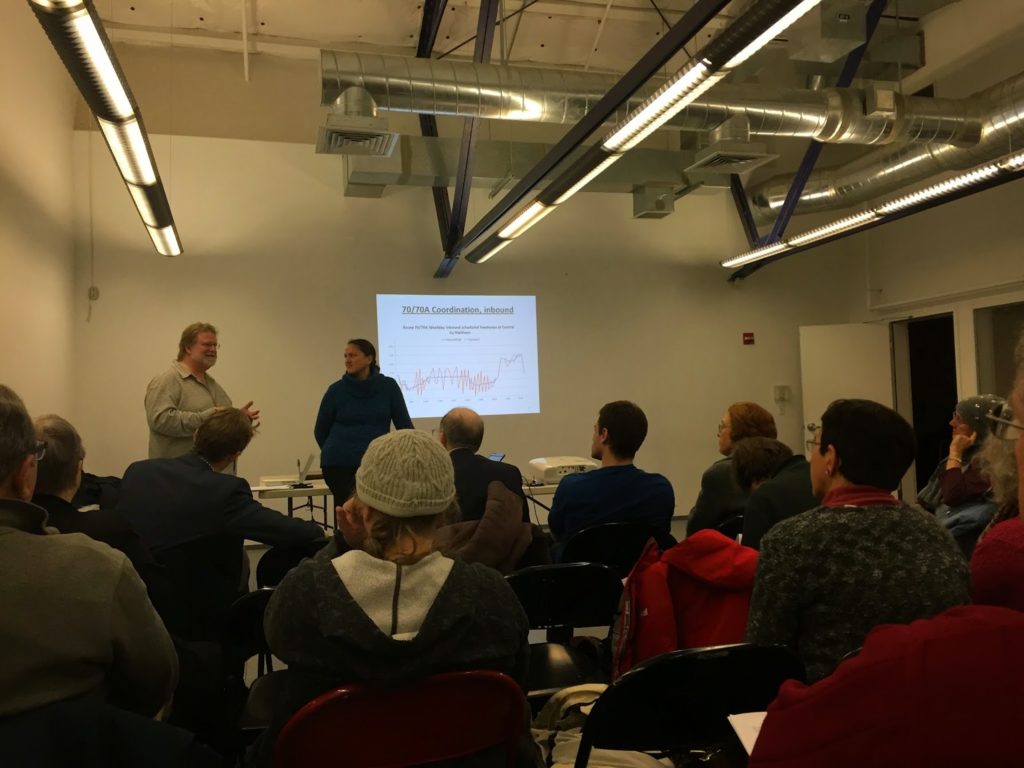 |
| A chart that looks conspicuously like one which has appeared on this page. |
I went to a public meeting tonight regarding the 70 bus. I go to a decent number of public meetings, and this one piqued my interest because of my interest (and use) of the 70. So I trudged out in the 5˚ temperatures to Watertown to talk bus schedules.
So did a couple dozen other people. But, of course, they didn’t want to talk about the nitty gritty of bus schedules. They wanted to air their completely unrelated concerns. Melissa Dullea, who manages to not roll her eyes back when people yell at her about completely unrelated topics, was great, and the conversation was steered slightly in the direction that it needed to go. She also gave me a shout-out and used a modified version of my 70 bus post to illustrate the headway issue on the route.
But we also got to discuss such important items as:
- Whether the T was going to eliminate stops at senior housing
- How the straps on the buses aren’t low enough and that’s why there isn’t enough capacity
- That people don’t move to the back of the bus and could drivers please make announcements more often (why people don’t take initiative and ask themselves is beyond me)
- It would be great if there was a device that would tell you when the next bus was coming that didn’t require a smart phone. We have those. They’re called smart phones. (The best exchange was when one guy said “it would be a big seller” and someone else said “no, it wouldn’t.)
- That those straps sometimes are missing completely and what can you do about it. (Why not tell the T the bus number.)
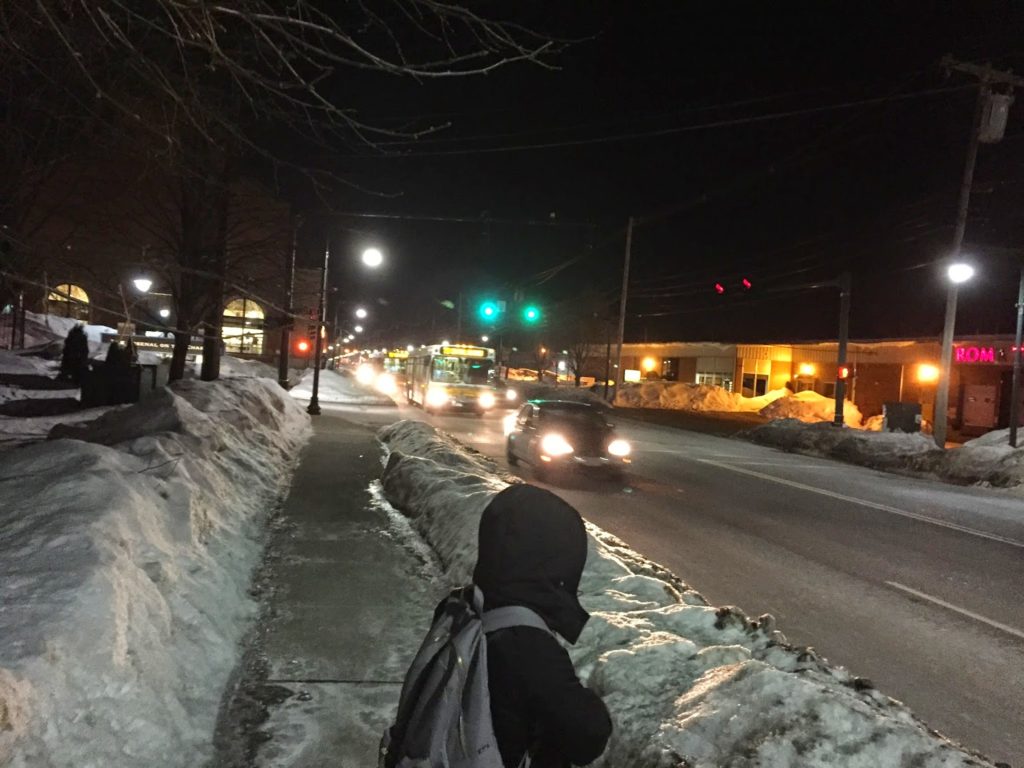 |
| Just another day riding the 70. Or, as I like to call it, the 140. |
Banned in Boston: a graduated income tax.
WBUR ran a poll asking about the MBTA. They asked how people rated the MBTA (78% fair or poor; or what it’s worth, I’d rate it “fair”) and how often it was a reliable means to get around (61% “most of the time” or “always”). Nearly everyone (85%) thinks that fixing the T should be a priority, and most blame the outdated system rather than management (66%, although Republicans are more likely to blame management).
They then asked people if they would support additional taxes or fees to help fund the T. 48% said they would. 48% said they would not. (Those who supported it split between somewhat and strongly support, although opposition is skewed towards strongly oppose.) The party crosstabs are somewhat interesting: even 30% of Republicans would support new taxes or fees, more than half of those strongly.
Most of the poll’s crosstabs don’t show anything particularly interesting, and I think the pollsters made a mistake by not asking people how they typically commuted, as that would have been a very interesting crosstab (I talked to the pollster and it may be forthcoming). However, what stands out is how the spread in responses varies. I expected it to vary by geography: people in Boston or “inner core” areas would support more taxes, or be more likely to blame an old system rather than wasteful management. But that’s not the case. Instead, the responses to these questions varies by income and education, which I assume are well-correlated.
For instance:
Q: “Which of the following do you think is most responsible for the issues this winter?”
A1: Old system and Maintenance
A2: Poor management
Overall under 25k 25-75k 75-150k 150k+
A1: 66 53 65 72 74
A2: 17 22 17 16 10
Wealthy voters are far more likely to blame the old system than poor management. For low-income respondents, they’re only a bit more than twice as likely to blame the system than the people. For higher income respondents, they’re seven times as likely. There are similar trends when you ask about funding shortfalls:
Q: What is responsible for the system’s financial shortfall?
A1: Not enough legislative funding
A2: Waste and mismanagement
A3: Prioritizing expansion over maintenance
Overall under 25k 25-75k 75-150k 150k+
A1: 30 19 25 35 39
A2: 36 41 36 39 32
Here, a high-income respondent is twice as likely to blame the legislature than a low-income one.
A1: 48 40 44 50 63
A2: 48 51 55 48 35
Here’s where I think it’s interesting. Wealthier respondents are far more likely to support more taxation. By a nearly two-to-one margin, people making more than $150,000 a year support more taxes, while people making less than half that much are against it. Herein lies the problem: how do you tax the people who make more—and are willing to pay more—without raising taxes on people struggling to get by.
The obvious answer is a progressive income tax. Massachusetts is one of few states without one. The problem with changing the tax structure is that progressive taxation is explicitly forbidden by the state constitution. Oh.
(Update: here’s a good primer on the state income tax with more up-to-date numbers.)
Right now, the standard deduction of $8800 for a family makes the tax structure is slightly progressive. I’ve calculated the tax paid under the current system and a proposed progressive system for various incomes (5.15% after the standard deduction). On the left are the median incomes for each quintile of earners in Massachusetts (from 2006, but the numbers haven’t changed too much since then). On the right are what would happen if you raised the standard deduction to 10,000 and had the following graduated rates: 4% to $25000, 6% to $75000, 8% to $150,000 and 10% on income above $150,000.
Income Tax Rate New Tax New Rate
$20,000 $577 2.8% $400 2.0%
$48,000 $2019 4.2% $1580 3.3%
$75,000 $3409 4.5% $3200 4.3%
$105,000 $4954 4.7% $5600 5.3%
Total/Avg* $19518 4.2%* $22480 4.3%*
Taxpayers in the lowest two quintiles of earners would see dramatic decreases in their taxes: $200 to $500 (25-35%), which, for lower earners, is likely to be spent, boosting the economy. The middle quintile would also see a small tax break: someone earning $75,000 would get a $200 tax break (5% decrease). Upper earners would see their rates increase, but the change would not be more than $1000 until it was well in to six figures (a million dollar earner would see their tax rate increase from 5.1 to 9.4% and pay an extra $43,000, but I think they’ll still get by).
For the Commonwealth, it would mean new revenue. Based on just these numbers, there would be an increase of 15% from income taxes. But the math is much more complicated than that involving calculus I’m not about to do here since the long tail of high income earners would pay more while the decreases at the lower end of the scale are more minimal, so the revenue increase would likely be a bit higher. So, most Massachusetts residents would get a tax break, and the Commonwealth would have more money to improve services for everyone. And according to the survey, higher income residents would be willing to pay more. It’s a win-win-win, but it can’t be implemented without amending the constitution.
There are two ways to get this on the ballot. One involves a majority of state legislators and is probably a non-starter: Beacon Hill types are notably averse to doing, well, anything. The other way is for 3% of Massachusetts voters would need to sign an initiative petition, and then 25% of two consecutive legislatures would have to approve it. 25% of two consecutive legislatures might actually have a chance. Then it would go to the voters.
The last attempt to make this change in 1994 (a Republican wave year) failed by a wide margin, but an attempt to end the income tax all together in 2008 failed by a wider margin. The political hurdles would be large, but it is clear that the state needs more money to invest, and it is clear that higher earners are willing to pay more taxes. Convincing everyone to vote for this—even if it would be a tax cut for most—would be the hardest part.
And to the naysayers who crow that it will drive away jobs, look at Minnesota. There, the governor raised the top scale of the income tax and turned a deficit in to a budget surplus, which is being reinvested in schools and infrastructure and targeted tax breaks for the working poor. Too bad that it’s a well-educated, progressive state that happens to get a lot of snow: does that sound familiar?
Tallying snow and cold in Boston
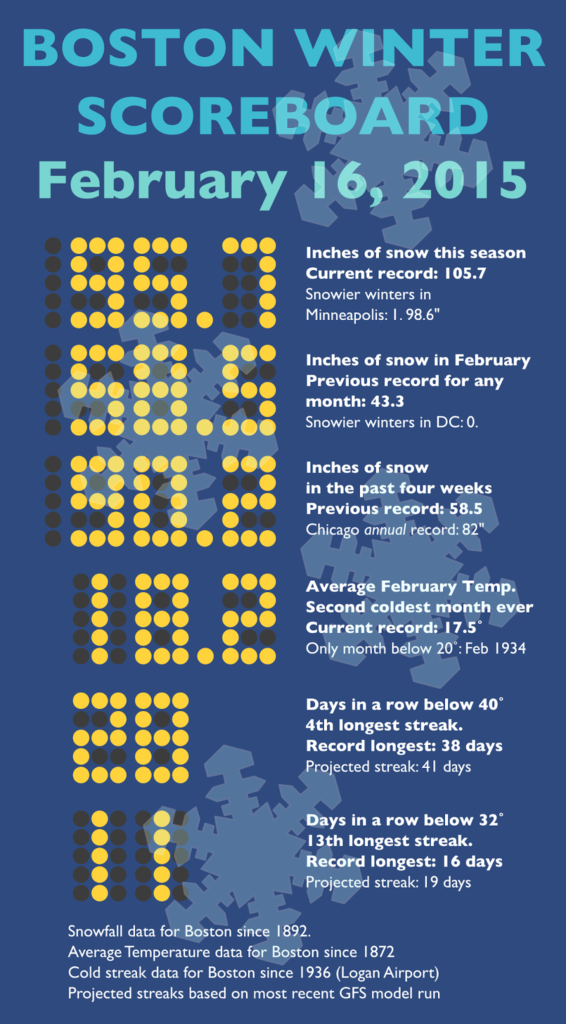 |
| I’ll update this scorecard for the next few weeks. Follow @ofsevit on Twitter for the latest version |
A few weeks ago, I wrote about how unprecedented the weather has been in Boston, and how it affects the transportation system. How unprecedented is this February? It is the confluence of two 500-year events: temperature and precipitation have both experienced anomalies at least 3 standard deviations from the mean. It is without parallel.
We covered snowfall in the last post, here we’ll focus more on the cold temperatures.
There has been one month, in the recorded climatological history of Boston, where the average temperature was below 20 degrees. 1934. It was unprecedented cold: the all-time record-low was set in Boston at -18 (a temperature which, with the observation station being moved to Logan Airport in 1936, will likely never be matched; the airport has only recorded three days below -10, the most recent in 1957). The average temperature in February 1934 was 17.5˚. The next highest months were Januarys in the late 1800s when the temperature averaged 20.1 (records date to 1872). Winter temperature records are very nicely normally distributed (69/96/99.7; other months are similarly distributed but there is much less nominal variability in the summer), and there has only once been a a month more than 3 standard deviations from the mean out of more than 400 winter months. 1934.
It is quite likely that eight decades later, 2015 will be the second. The dreaded polar vortex last year gave us departures from the mean of 2 to 3 degrees. (To be fair, we were on the edge of the vortex last year, and the Upper Midwest had similarly anomalous weather.) This year, we’re likely to run more than 10 degrees below normal. The average high for mid-February is 40˚. We haven’t seen that temperature in nearly a month, one of the longest stretches on record.
 Thus far, temperatures in Boston have averaged 18.2 degrees, and if the forecast for the next week holds up, the average will actually fall below the 1934 record. With five days beyond then in the month, even if we revert to seasonal climatology normals (unlikely, given the current pattern and modeling), we’d set the second coldest month on record. If the weather stays cold, as is advertised, we’ll see the second winter month more than three standard deviations from the mean. And we might break the all time coldest monthly record. Which, given climate change (mean temperatures have risen 3-4 degrees since 1872), is particularly impressive.
Thus far, temperatures in Boston have averaged 18.2 degrees, and if the forecast for the next week holds up, the average will actually fall below the 1934 record. With five days beyond then in the month, even if we revert to seasonal climatology normals (unlikely, given the current pattern and modeling), we’d set the second coldest month on record. If the weather stays cold, as is advertised, we’ll see the second winter month more than three standard deviations from the mean. And we might break the all time coldest monthly record. Which, given climate change (mean temperatures have risen 3-4 degrees since 1872), is particularly impressive.
Apparently it has snowed quite a bit as well. And, yes, the seven feet in three weeks has never happened before (and may well never happen again), and the past month has already outpaced any winter season in Chicago, New York or DC (and is one storm away from topping Minneapolis). But without the cold temperatures, it wouldn’t have had the same effect: some snow would have melted even with a few days over 40˚. In 1978, days in the 40s and 50s helped reduce the snowpack to 4″ before The Blizzard. In 2013, a week in the 40s reduced a major blizzard to a few inches of crust. This year, we haven’t seen 40˚ since MLK Day. The snow combined with the temperatures is really a double-whammy: two once-in-500-year events, at the same time.
 |
| From Sam Lillo @splillo |
It’s something no one could have planned for, and something we’ll never see again. And I do need to update one of the charts in that first post: the 28 day snowfall. The current chart is here. But it may increase.
Update: According to Sam Lillo, who has some great posts like this one, Boston has had more snow in the past month that Buffalo ever has. Will try to confirm (confirmed).
Commuter Rail Ridership and Fares
A Twitterer recently found a 1972 plan for transit-level service along many of Boston’s rail corridors and was floored that ridership on what we now know as Commuter Rail at that time was only 16,000 per day (it was 80,000 in the ’40s and now hovers around 70,000). It has indeed grown, especially the South Side lines: in 1972, only 600 people rode the Worcester Line daily (the then-speedy Mass Pike having recently opened); many single Worcester Line trains now carry that many; the line has grown more than 15-fold over the past 40 years.
But the time of impressive growth is even more impressive: in 1981, ridership on Commuter Rail still hovered around 17,000. And then it began to grow. By 1990, it had more than doubled. And during the 1990s, it more than doubled again, so that by 2000 there were more than four times as many riders as there had been two decades before. Some of this is attributable to extensions after service cuts in the ‘70s, and new service on the Old Colony Lines. But a lot is due to the revitalization of downtown Boston following the growth of the 128 corridor, worsening traffic, and higher parking costs.
For 22 years, from 1981 to 2003, Commuter Rail traffic grew every year but one: 1991, after the collapse of the “Massachusetts Miracle.” But it took off again thereafter, peaking at 74,000 daily riders in 2003.
It hasn’t been that high since.
At first, flat ridership could be blamed on the early-2000s recession. But in the past 15 years, ridership has stagnated. If ridership growth had continued, linearly, at the 1981-2003 rate, it would be poised to cross the 100,000 threshold this year. Instead, the numbers of riders has barely budged, fluctuating up and down as the economy, traffic, and the price of gas has ebbed and flowed, none of them seeming to dramatically affect ridership.
Except for fares. Take a look at the chart. It certainly seems that, once fares started to rise dramatically, ridership flattened out. In the last fifteen years, commuter rail fares have gone up 250%, while they didn’t rise that much in the 20 previous years (despite higher inflation). Subway fares have risen as well, but the nominal amount the fares have risen is very different.
In the ’80s and ’90s, a ride on the T cost 60 or 85 cents (that’s a token, by the way) while Commuter Rail fares ranged from $1.75 to $3, rising to $2.25 to $4. The ratios were similar to today (the highest Commuter Rail fare about five times a subway fare), but the difference only $3. Now? The difference between a tap of a Charlie Card and a punch of a ticket is $8, which is a much greater difference.
There are two salient bits here. First, subway ridership, despite the same relative rise in fares, has seen dramatic increase in passenger counts in recent years, despite the increases in fares. At issue here is the fact that Commuter Rail and urban rail are different populations: Commuter Rail passengers have more options. Most own cars. If the cost of driving and parking is not much more than commuter rail—and parking and driving costs haven’t more than doubled in the past 10 years—they are more likely to abandon the rails and head for the highways. If the MBTA provided excellent rail service, with fast speeds and reliability, this would be less of an push factor. But with old equipment and slow track, it is.
The second piece is that outside of peak travel times, the train generally can’t compete with vehicles on travel time, and on weekends, on ease or cost of parking. And while many trains at rush hour are near capacity, there is plenty of capacity on off-peak and weekend trains. It’s possible that if the T offered off-peak savings—say, $2 off all fares beyond zone 1A, or half off, or something—they could drive enough additional ridership to cover the lost fare revenue, all the while taking cars off the road, which is good for everyone. As would having sensible, clockface midday schedules. And it might even help ridership trends.
It’s rather obvious that Commuter Rail ridership is more elastic than subway ridership: when fares go up, ridership might not go down, but previous trends level off. Since urban riders would cry foul if local fares rose faster than Commuter Rail fares (the subsidy per ride is higher for Commuter Rail riders, although the subsidy per mile is about even), increasing Commuter Rail ridership would require better service. Given the recent performance of the Commuter Rail, this may be a tall order. But it should be a goal.
In defense of the MBTA: This weather is unprecedented
 |
| How unprecedented is three and a half feet of snow in a week? Very. |
The calls have gone out. The T screwed up. Some yammer that “it was much worse when I was young” (and we walked uphill to school in it, both ways). Some tell the MBTA that they should be prepared for winter, come on, it’s just a little bit of snow.
The thing is, it is way more snow that has ever fallen. Ever.
How many ski resorts in the US average 6 inches of snow every day (assuming all the snow falls in four months—which it doesn’t)? Zero. Sure, once in a while Squaw or Alta will see 800 inches of snow in a year (2011), and Mount Washington once tallied 567 inches in a year, but the averages are lower. Buffalo might get five feet of snow in a week, but not every week. 40.8 inches of snow a week from December through March adds up to 692 inches of snow. Or 58 feet. What I’m trying to say is that no one, anywhere, is really used to getting three and a half feet of snow a week.
I took the pains of pulling the last 79 years of Boston’s weather data from the National Climate Data Center. It goes back further, but from a different site—not at the airport—which would have required another data pull. Plus, in 1936 the T, well, BERy, was very different, no major highways had been built, and anyone who is under 90 can’t really remember that much from the mid 30s anyway. Sure Grandpappy may go on about the hard winter of ’23, but he also was yelling at Fox News for 45 minutes yesterday. (Here’s the annual data back to 1892, by month)
Anyway, back to the data. In the 7 days ending February 2, there were 40.8 inches of snow. This is unprecedented. The previous record was 31.2 inches, so not only did we break the record, we smashed it by 30%. This would be like if Mark McGwire had broken Roger Maris’s record of 61 home runs and hit 79, and it should be noted that he did this with a second head growing out of his neck. The record wasn’t just broken. It was smashed.
The past two weeks have also seen the snowiest 4 days on record, the snowiest 5 days on record, the snowiest 6 days … well, you get the idea. All the way up to the snowiest two weeks on record. Take any time period between three days and two weeks, and the amount of snow that has fallen in the past couple of weeks has eclipsed anything that has ever happened. So, sorry, Grandpa, it wasn’t like this all the time when you were young. It was never this bad.
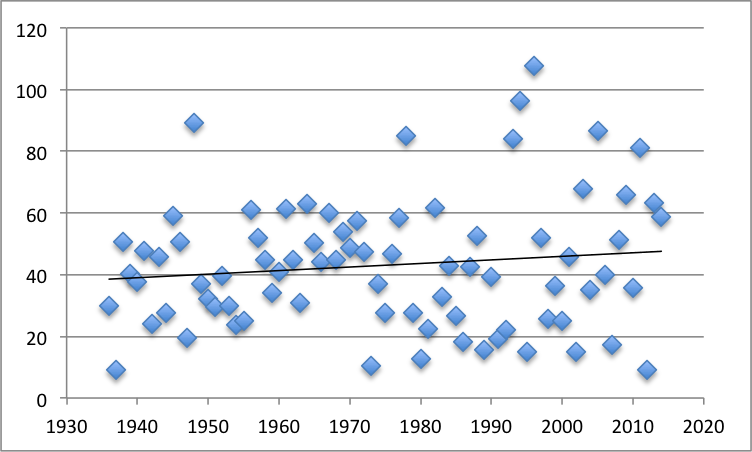 |
| Annual snowfall in Boston |
Even if you take it out to four weeks, the 10 days ending February 2 are actually 7th on the list. (Unlike some “analysts“, I did not use bizarre rolling averages to pump up the numbers. Any time a date was duplicated, I discarded all but the highest. Also, go Patriots!) If another 13 inches of snow falls in the next 18 days, 2015 will have the highest four week snowfall in history. Looking at the weather models for the next few days, I’d take the over.
So, Grandpa was wrong. It was never like this when he was young. (And despite climate change, the annual snowfall totals are trending up, although there appears to be more variability, too.)
So let’s get to the second part: shouldn’t the T be prepared for winter? Doesn’t winter come pretty regularly every year? Sure. And they probably are. But here’s the thing: winters are variable, and the T is not prepared for all of winter to come in a period of 8 days. If you’re following along, in the 8 days ending on February 2, Boston had 46 inches of snow. That’s Buffalo territory. Hell, that’s Houghton, Michigan-like. And it’s more snow than falls in an average year.
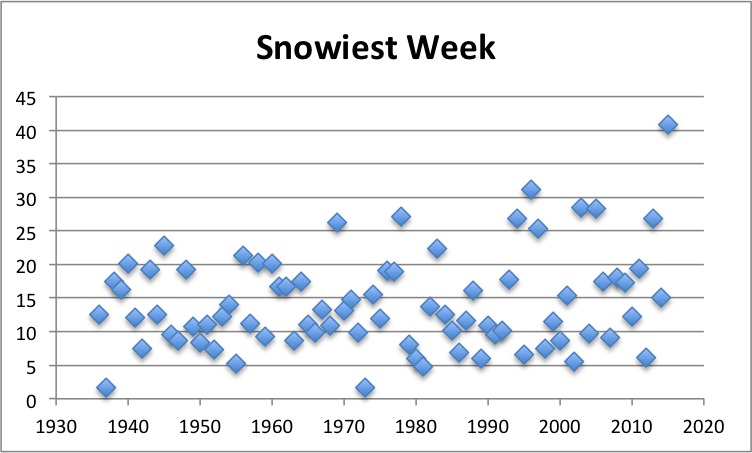 Since 1936, the average snowfall in Boston has been 43 inches. The median is 40.9—a few big winters skew the total up, and since negative snow can’t fall, the floor is 0. Since 1892, just 45 winters have had more than 46 inches of snow. So the past eight days have had more snow than 64% of the winters in the past 122 years. I don’t fault the T for not preparing for this: it’s something that is really off the charts.
Since 1936, the average snowfall in Boston has been 43 inches. The median is 40.9—a few big winters skew the total up, and since negative snow can’t fall, the floor is 0. Since 1892, just 45 winters have had more than 46 inches of snow. So the past eight days have had more snow than 64% of the winters in the past 122 years. I don’t fault the T for not preparing for this: it’s something that is really off the charts.
The average highest seven days of snowfall in a year is 14 inches. The standard deviation is 7.12 inches. 40 inches is about three and one half standard deviations above the mean. If we make the assumption that these data are normally distributed (and the numbers are 72% within 1 stdev, 96% within 2, and 97.2% within 3, although of course before this year it was 98.7%; this lines up pretty well with the 68/95/99.7 normal distribution despite our relatively small sample size), this amount of snow is something we’d expect less than once every 100 years. Should the T be completely prepared for a once-in-a-century occurrence? Should we spend tens of millions on snow clearance preparation when we’re just as likely to have a winter with a foot of snow as a single week with three feet? With a tight budget, you need priorities, and one of the T’s priorities has been running on a lean staff. No longer are there track gangs who sit by idly all winter waiting for snow. And preparing for—and staffing up for—the proverbial 100 year storm is probably not at the top of the T’s list.
So cut the T—and the highway crews, and the guys in front-end loaders clearing curbs—some slack. They’re dealing with something they’ve never seen before, and it’s amazing that the transportation system is working at all. This is not what your parents dealt with every winter back in the day. This is not something that the T could have remotely been prepared for. It’s never happened before. And if the current weather models hold up, the snow is not anywhere close to done.
If we’re lucky, this might be the jolt that politicians need to move the needle away from “blame the T” to “let’s see if we can do something about the T.” This might be the MBTA’s Muni Meltdown moment (although calling it a meltdown wouldn’t really work). Hopefully something good will come of it as we have a necessary conversation about adequately funding the system (and not just the Olympics).
Oh, let’s just hope there’s somewhere to put all the snow.

